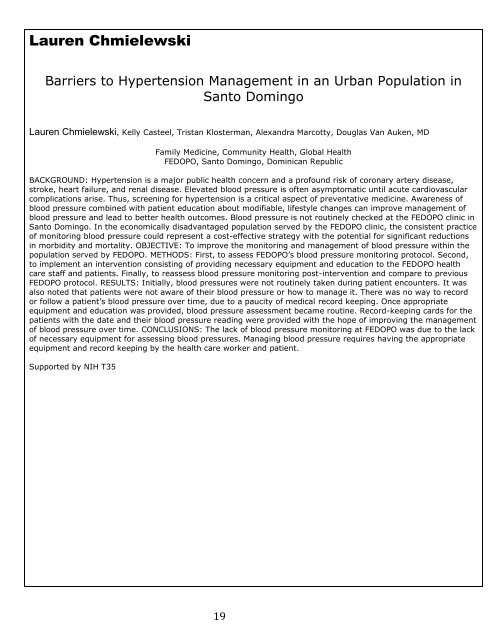student research day - Case Western Reserve University School of ...
student research day - Case Western Reserve University School of ...
student research day - Case Western Reserve University School of ...
Create successful ePaper yourself
Turn your PDF publications into a flip-book with our unique Google optimized e-Paper software.
Lauren Chmielewski<br />
Barriers to Hypertension Management in an Urban Population in<br />
Santo Domingo<br />
Lauren Chmielewski, Kelly Casteel, Tristan Klosterman, Alexandra Marcotty, Douglas Van Auken, MD<br />
Family Medicine, Community Health, Global Health<br />
FEDOPO, Santo Domingo, Dominican Republic<br />
BACKGROUND: Hypertension is a major public health concern and a pr<strong>of</strong>ound risk <strong>of</strong> coronary artery disease,<br />
stroke, heart failure, and renal disease. Elevated blood pressure is <strong>of</strong>ten asymptomatic until acute cardiovascular<br />
complications arise. Thus, screening for hypertension is a critical aspect <strong>of</strong> preventative medicine. Awareness <strong>of</strong><br />
blood pressure combined with patient education about modifiable, lifestyle changes can improve management <strong>of</strong><br />
blood pressure and lead to better health outcomes. Blood pressure is not routinely checked at the FEDOPO clinic in<br />
Santo Domingo. In the economically disadvantaged population served by the FEDOPO clinic, the consistent practice<br />
<strong>of</strong> monitoring blood pressure could represent a cost-effective strategy with the potential for significant reductions<br />
in morbidity and mortality. OBJECTIVE: To improve the monitoring and management <strong>of</strong> blood pressure within the<br />
population served by FEDOPO. METHODS: First, to assess FEDOPO’s blood pressure monitoring protocol. Second,<br />
to implement an intervention consisting <strong>of</strong> providing necessary equipment and education to the FEDOPO health<br />
care staff and patients. Finally, to reassess blood pressure monitoring post-intervention and compare to previous<br />
FEDOPO protocol. RESULTS: Initially, blood pressures were not routinely taken during patient encounters. It was<br />
also noted that patients were not aware <strong>of</strong> their blood pressure or how to manage it. There was no way to record<br />
or follow a patient’s blood pressure over time, due to a paucity <strong>of</strong> medical record keeping. Once appropriate<br />
equipment and education was provided, blood pressure assessment became routine. Record-keeping cards for the<br />
patients with the date and their blood pressure reading were provided with the hope <strong>of</strong> improving the management<br />
<strong>of</strong> blood pressure over time. CONCLUSIONS: The lack <strong>of</strong> blood pressure monitoring at FEDOPO was due to the lack<br />
<strong>of</strong> necessary equipment for assessing blood pressures. Managing blood pressure requires having the appropriate<br />
equipment and record keeping by the health care worker and patient.<br />
Supported by NIH T35<br />
19
















